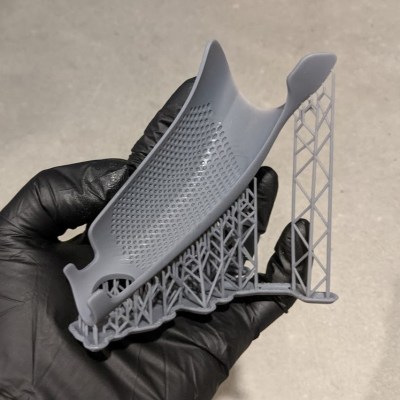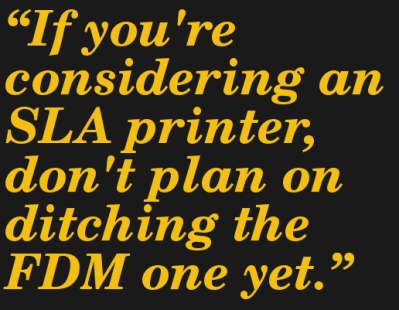Adding a resin printer to one’s workbench has never looked so attractive, nor been so affordable. Complex shapes with effortlessly great detail and surface finish? Yes, please! Well, photos make the results look effortless, anyway. Since filament-based printers using fused deposition modeling (FDM) get solid “could be better” ratings when it comes to surface finish and small detail resolution, will a trusty FDM printer end up retired if one buys a resin printer?
The short answer is this: for users who already use FDM, a resin-based stereolithography (SLA) printer is not likely to take over. What is more likely to happen is that the filament printer continues to do the same jobs it is good at, while the resin printer opens some wonderful new doors. This is partly because those great SLA prints will come at a cost that may not always justify the extra work.
Let’s go through what makes SLA good, what it needs in return, and how it does and doesn’t fit in with FDM.
WHEN SLA IS GOOD, IT’S REALLY GOOD

The sweet spot for resin printing is this: small objects with smooth finishes, organic curves, and surface details. With SLA, these objects print more reliably and at a consistently higher quality than with FDM — as long as the operator does a good job with layout and support placement, anyway.
A big reason for this is that SLA does not produce layer lines the way FDM does. FDM prints are notorious for visible layer lines, and those lines are at their worst when spread across curved surfaces. SLA still creates objects one layer at a time, but the process doesn’t leave obvious lines.
There is also more freedom in part orientation when printing in resin. Unlike FDM, resin prints are isotropic. In the context of 3D printing, this means that the printed object’s physical properties do not change with respect to physical orientation. As long as a part is supported enough to print properly, a resin printer doesn’t much care in which orientation or at what angle it builds an object; the result will come out the same. This gives SLA printers more flexibility when it comes to part orientation, which helps when trying to keep presentation surfaces and details free from supports.
NICHE APPLICATIONS FOR SLA’S STRENGTHS
One example of a niche for what resin printing is good at is gaming miniatures and figures. Tabletop enthusiasts are buying printers and resin, and designers of gaming-related models are finding success as well. The more successful ones thrive on sites like Patreon, with thousands of monthly supporters.
Engineering applications can have a place with SLA, so long as the objects are small enough. The build volume of most SLA printers is revoltingly tiny compared to FDM, but they make up for it with the ability to handle shapes and details that FDM would have problems with.
BEWARE SLA’S ADDED COSTS
SLA printing brings some annoying buddies everywhere it goes in the form of added costs. These aren’t costs for the machines themselves; hobbyist SLA printers are very affordable. These ongoing costs are for consumables, increased time for upkeep and part processing, and storage space.
SLA requires more setup and cleanup than FDM. Printed parts need to be washed (usually in an alcohol bath) after printing, and possibly post-cured with additional UV exposure. Since resin is messy, disposable gloves and a spill-resistant work area are required. Another thing to consider is that resin isn’t meant to be left sitting in a printer for long periods, so when printing is done for the forseeable future, it’s time to empty the printer and clean the parts.
All of this takes time, but it also takes up valuable space in a work area. Bottles of resin, containers of alcohol, wash bins, gloves, a drip-proof work space, all of it takes up storage and table space. SLA printing as a whole will take up far more room than just the printer itself.
The other thing to consider is the need for manual post-processing. Resin prints tend to require a lot of supports, and those supports need to be removed by hand. These leave behind small marks that may need to be sanded away. With FDM, supports are a last resort that are used only if needed, but with SLA they are the rule rather than the exception.
THINGS FDM IS STILL GOOD AT
A well-maintained FDM printer is a fantastic tool for prototyping, iterating on designs, and creating functional parts. FDM also has other advantages that really stand out when contrasted with resin printing.
FDM is perfectly happy to wait patiently until needed, at which point a print can be started with a minimum of fuss. The consumables are few and reasonably priced. Filament is best stored in a dry environment, but besides that, it doesn’t ask for much. Swapping filament types or colors is simple, clean, and easy. Even a failed print doesn’t usually involve much more than sweeping away a mess of plastic and trying again.
 The biggest disadvantages are related to layer line visibility, the resolution of surface detail, and working with curved organic shapes. None of these can be waved away, but they can be mitigated to some extent. Variable Layer Height tries to address layer line visibility, and it is a feature that has worked its way into most slicer software. The ability to render very small details and features can be improved, to some extent, by swapping a printer’s standard 0.4 mm nozzle for a smaller one.
The biggest disadvantages are related to layer line visibility, the resolution of surface detail, and working with curved organic shapes. None of these can be waved away, but they can be mitigated to some extent. Variable Layer Height tries to address layer line visibility, and it is a feature that has worked its way into most slicer software. The ability to render very small details and features can be improved, to some extent, by swapping a printer’s standard 0.4 mm nozzle for a smaller one.
FDM printers are most challenged by being asked to print curved objects that have no flat areas and no real “up” or “down”. One option is splitting these objects into smaller and more easily-printed ones, but that’s not always practical. Printing a tricky model will require supports, and supports with FDM always result in degraded surface quality. Water-soluble support structures can help mitigate this, but doing so requires multi-material printing. SLA, on the other hand, is far more suited to such objects.
IS THERE ROOM FOR BOTH?
Resin prints look fantastic and it may be tempting to think of SLA as superior to FDM, but that is not the whole story. They are different tools, and good at different things. Unless your needs are very specific, you’ll probably benefit from access to both.
If you need to print small objects with good surface finish and detail resolution, and you can deal with the added hassles of working with resin, then SLA is definitely for you. But even if you only print small objects, a working FDM printer can easily earn its place on your workbench with the ability to create functional parts without any significant setup and cleanup. If you’re considering an SLA printer, don’t plan to ditch FDM just yet.
I regularly use both but personally, I always choose a filament-based printer if possible; even if a final model will eventually be printed in resin, it’s simply cheaper and faster and easier to prototype and iterate with FDM.
If you have access to both, has this also been your experience? Do you know of a niche for resin printing that hits the spot in a way nothing else does, the way SLA has done with tabletop enthusiasts? We want to hear all about it, so let us know in the comments.
No comments:
Post a Comment